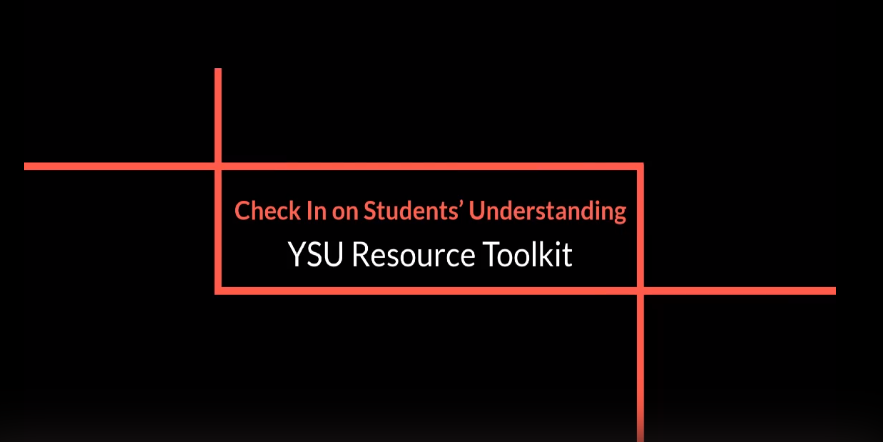-
-
Colleges
-
-
Student Experience Greek Life Housing & Dining Health & Recreation Our Campus Community Engagement Athletics
-
I want to CHECK IN ON STUDENTS UNDERSTANDING.

Click on the image above to view the video!
This video is a walkthrough of the strategies, technology, and resources found on this outcome webpage. It was recorded during the summer Resource Toolkit Workshop Series (July 2020). You can access the video using your YSU credentials. Please contact atkaufman@ysu.edu if you are unable to access the video.
While course evaluations can be a useful tool to capture a summative overview of a student’s learning and experience in a course, they do little to provide feedback for how to improve a course that is in progress. We recommend engaging in formative, low stake assessment that gives students a voice and provides you as an instructor information on how to improve and/or continue your support of students in your course. You can do this a few weeks into the semester and again at the midpoint.
Research points to this type of low-stakes check-in as beneficial for student behavior and learning in the course (Cohen, 1980; Diamond, 2004; Hurney et al, 201); look at a YSU part-time faculty member, Dr. Janet Gbur’s experience asking students for course feedback.
- Examples of Questions to Ask
You can approach the types of questions you ask through several lenses – you may want to gauge learning (if so, check out the Classroom Assessment Techniques section below), get a sense of what students think about the course, or see how students' lives are being effected outside of school. First, establish your purpose, then design your question protocol or tool. Some examples of questions include:
- What helps/hinders your learning in this course?
- What suggestions do you have for me to improve learning in this course?
- What do you like most/least about this course so far?
- What should we start/stop/keep doing in this course?
- What specific advice would you give to help your instructor improve learning in this course?
There is also benefit in asking “learner-centered” questions. Some examples include:
- What are YOU doing to help your learning in this course?
- What are YOU doing to hinder your learning in this course?
- What could YOU be doing to improve your learning in this course?
- What steps could YOU take to improve your own learning in this course?
These types of questions may provide you useful information in connecting students to campus support. You may simply want to check-in with students and find out more about their lives during Covid-19. You can follow these instructions for a 2-question survey template you can use with your students.
- Technology Available for Collecting Students' Responses
You may have access to many different tools you can use to collect formative evaluation from students and to check-in on their understanding (e.g. Survey Gizmo, Google Forms, Survey Monkey). We recommend using the Office 365 survey tool, Microsoft Forms (PDF Tutorial).
You can also utilize Blackboard to:
- Create a no-credit test to find out about students’ habits in accessing your online material. You can ask them quiz questions such as -- I have a reliable computer or laptop to access for this course (True/False); I know how to contact my professor if I have any questions (True/False); I know where to find the revised syllabus (True/False). (Blackboard Original Tutorial; Blackboard Ultra Tutorial)
- Create a discussion board (ACUE, 2020) specifically, for students to ask and answer questions for each other about the course and technology questions. You can then monitor the discussion board for places were students may be lacking understanding. (Blackboard Ultra: Discussion Boards; Blackboard Original: Discussion Boards)
You can also utilize video-conferencing tools to:
- Set-up times to meet with each student individually or in small groups and hold informal interviews/focus groups to collect feedback on how they are doing personally and in the course using WebEx (PDF Tutorial), Blackboard Collaborate (Webinar), or Microsoft Teams (LinkedIn Learning Video, Access with YSU Credentials).
- Classroom Assessment Techniques
Classroom Assessment Techniques (CATs) are simple, non-graded activities to gather feedback from students on teaching and learning. They are not meant to assess an individual student’s understanding, but to gather understanding from the whole class. They can be done in person or through technology tools.
Here are two examples that you may want to utilize in your course:
- MINUTE PAPER: Give students one minute to respond to 2 questions - “What is the most important thing you learned today?” and “What is something important you still need to learn?” The papers should be collected, but anonymous. You can do this on an actual sheet of paper in a face-to-face course, create a shared Word Document (PDF Tutorial), share the link with students, and have students type in the information anonymously. You could also create a 1 question open response question in Microsoft Forms (PDF Tutorial).
- MUDDIEST POINT: Give students the opportunity to respond to the question, “What was the most confusing point during class today?” Similar to the minute paper, you can do this on a notecard/piece of paper in a face-to-face course, through a shared Word Document, or through a Microsoft Form.
For a list of 50 CATs, visit the University of Kentucky’s Center for the Enhancement of Learning and Teaching.
